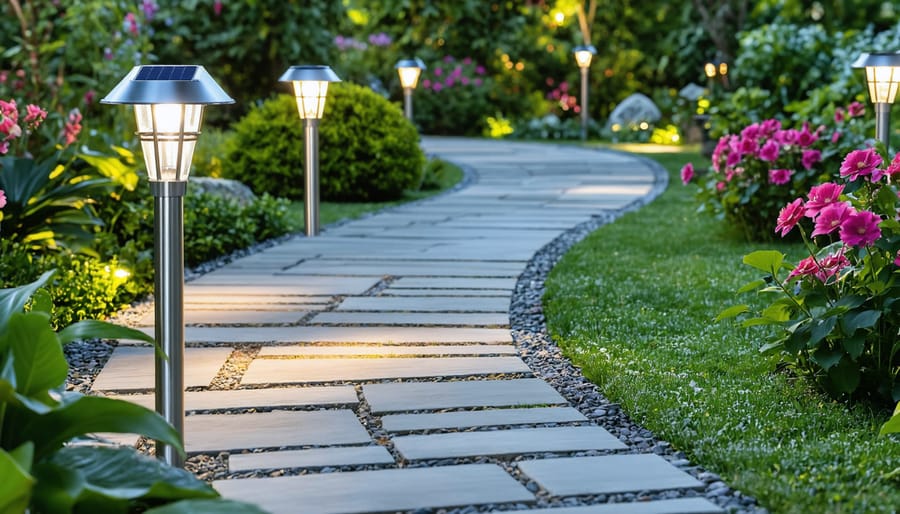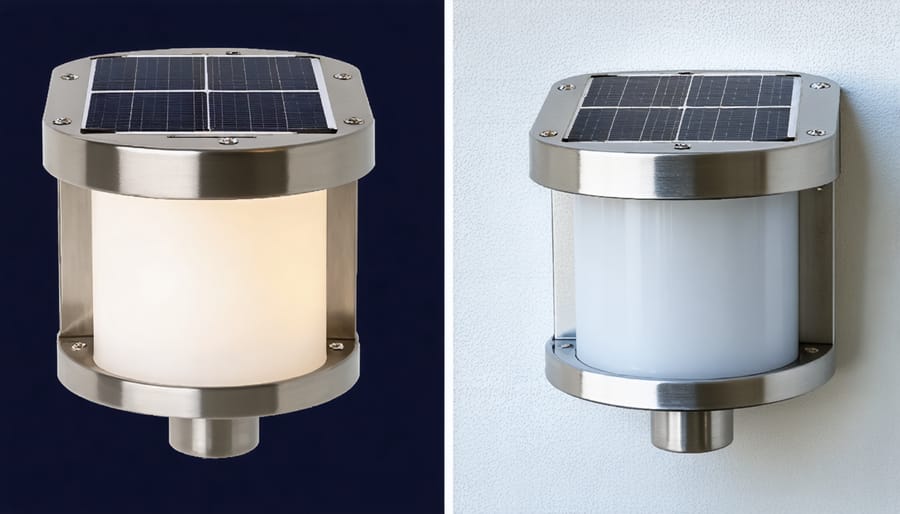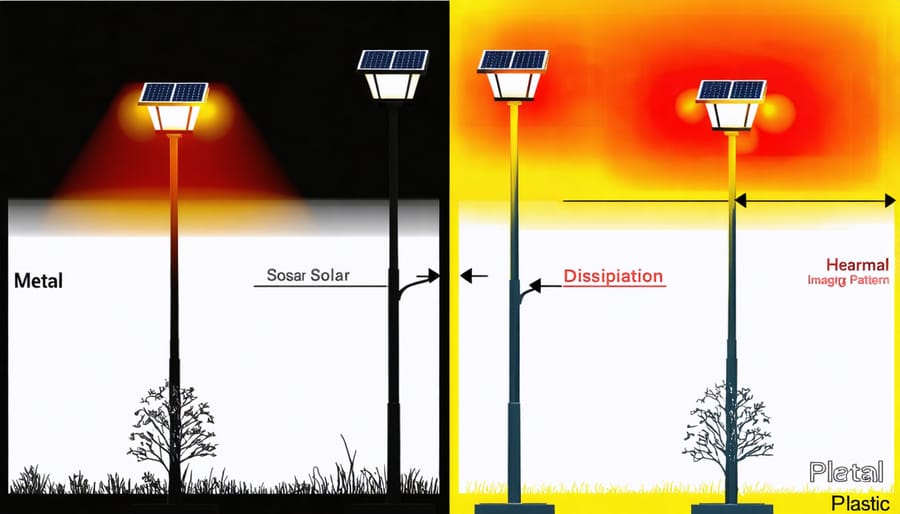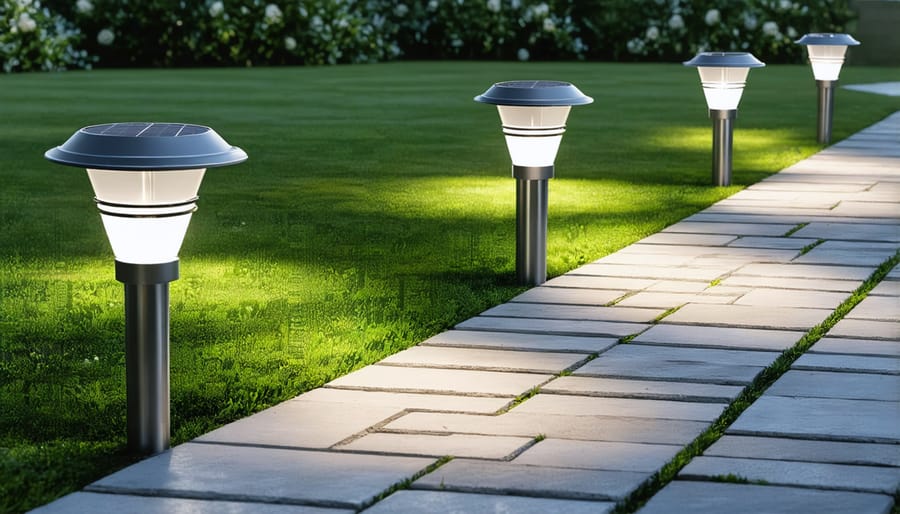Metal Solar Path Lights That Actually Last: European Engineering Meets Garden Elegance

Transform your outdoor spaces with premium metal efficient solar path lighting that combines durability with sophisticated design. Crafted from marine-grade stainless steel and aircraft-grade aluminum, these sustainable illumination solutions deliver unmatched longevity while elevating your landscape’s aesthetic appeal. Modern metal solar lights integrate advanced photovoltaic technology with precision engineering, offering superior light output and reliable performance in all weather conditions. Their corrosion-resistant construction and tamper-proof designs make them ideal for both residential pathways and commercial installations, providing years of maintenance-free operation while reducing energy costs. This perfect fusion of European craftsmanship and sustainable innovation represents the future of outdoor lighting, where style meets environmental responsibility.
Why Metal Makes the Difference in Solar Path Lighting
Weather Resistance and Durability
Metal solar pathway lights offer exceptional durability and resistance to various weather conditions, making them a superior choice for outdoor illumination. Stainless steel variants, particularly grade 316, provide outstanding protection against corrosion and rust, even in coastal areas where salt exposure is high. This marine-grade steel maintains its structural integrity and aesthetic appeal through years of exposure to rain, snow, and UV radiation.
Aluminium fixtures, while lighter than stainless steel, offer excellent weather resistance when properly treated with powder coating or anodisation. These treatments create a protective barrier that prevents oxidation and maintains the fixture’s appearance. Bronze and copper options develop an attractive patina over time while remaining structurally sound, adding character to your outdoor space.
For optimal durability, look for IP65 or higher-rated fixtures, ensuring complete protection against dust and water ingress. Quality metal fixtures also feature robust seals around solar panels and LED components, preventing moisture damage to internal electronics. When properly maintained, premium metal solar lights can withstand extreme temperature variations from -20°C to +60°C, offering reliable performance throughout all seasons.

Heat Dissipation and Performance
Metal construction in solar pathway lights plays a crucial role in heat management and overall performance. The superior thermal conductivity of metal housings efficiently draws heat away from sensitive components, particularly the LED lights and solar cells. This natural cooling effect helps maintain optimal operating temperatures, even during extended periods of intense sunlight.
Unlike plastic alternatives, metal fixtures prevent heat buildup that could otherwise degrade electronic components and reduce light output. The enhanced heat dissipation directly contributes to longer LED lifespans and more consistent illumination throughout the night. Premium-grade aluminum and stainless steel constructions typically maintain their cooling properties for years, resisting degradation from weather exposure.
The thermal management benefits of metal construction extend to the solar panels as well. By keeping photovoltaic cells cooler, metal housings help maintain optimal charging efficiency. This results in better battery charging during daylight hours and more reliable performance during nighttime operation. Additionally, the durability of metal construction ensures these thermal management properties remain effective throughout the product’s lifetime, making metal solar lights a sustainable long-term investment for outdoor illumination.

Smart Design Features of Premium Metal Solar Lights
Integration with Smart Garden Systems
Modern metal solar pathway lights are increasingly embracing smart technology, offering sophisticated control and monitoring capabilities that enhance both functionality and user experience. Through dedicated mobile applications and home automation systems, users can now remotely manage their pathway lighting, adjusting brightness levels and scheduling operation times to suit their needs.
Many contemporary models feature Bluetooth or Wi-Fi connectivity, enabling seamless integration with popular smart home ecosystems like Google Home and Amazon Alexa. This connectivity allows for voice-controlled operation and coordination with other garden features such as irrigation systems and security cameras.
Advanced models incorporate motion sensors and ambient light detection, automatically adjusting illumination based on surrounding conditions and movement. Some systems even offer weather-responsive programming, adapting their performance during adverse conditions to maintain optimal efficiency.
Energy monitoring capabilities provide real-time data on power consumption and solar charging performance, helping users optimize their lighting system’s effectiveness. Many smart systems also send maintenance alerts, notifying owners when components need attention or when performance isn’t meeting expected standards.
For commercial installations, centralized management systems enable property managers to control multiple lighting zones across extensive grounds, ensuring efficient operation while maintaining security and aesthetic appeal. These enterprise-level solutions often include detailed analytics and reporting features, supporting sustainable facility management practices.
Advanced Light Distribution Technology
Metal construction in solar pathway lights revolutionizes outdoor illumination through sophisticated light distribution engineering. The precision-crafted metallic housing enables optimal light distribution patterns, ensuring uniform coverage without harsh spotlighting or dark zones.
The structural integrity of metal fixtures allows for advanced reflector designs that maximize LED efficiency. These carefully engineered reflectors direct light downward and outward at precise angles, illuminating pathways effectively while minimizing light pollution. The thermal conductivity of metal also plays a crucial role, helping maintain consistent LED performance and extending bulb lifespan.
Premium metal pathway lights feature specialized diffuser designs that soften and spread illumination evenly across walking surfaces. This thoughtful engineering creates a welcoming ambiance while ensuring safety through consistent visibility. The robust construction permits the integration of sophisticated lens systems that can be precisely adjusted to achieve different lighting effects based on specific landscape requirements.
European engineering standards have driven innovations in light distribution technology, particularly in developing anti-glare features and weather-resistant optical components. These advancements ensure that metal solar lights maintain their performance integrity throughout varying seasonal conditions, providing reliable illumination year-round.
Installation and Maintenance Best Practices

Professional Installation Tips
Begin by selecting an optimal location for your metal solar pathway lights, ensuring they receive 6-8 hours of direct sunlight daily. Mark your intended placement points, spacing lights 2-3 metres apart for balanced illumination. Before installation, conduct a soil assessment to determine ground stability.
For proper mounting, first clear any vegetation or debris from the installation area. If working with hard soil, pre-drill holes using a manual auger to prevent stake damage. Insert the mounting stakes at a 90-degree angle, ensuring they penetrate at least 20 centimetres into the ground for optimal stability.
Assemble the light fixtures according to manufacturer instructions, typically connecting the pole sections and attaching the solar panel unit. Before final placement, check that all connections are weather-tight and secure. When mounting the lights, align solar panels to face south in the Northern Hemisphere for maximum solar exposure.
Allow the units to charge for a full day before first use. Test the lights’ operation during evening hours and adjust positioning if needed. For installations on concrete or paved surfaces, use appropriate mounting brackets and anchors designed for hard surfaces. Remember to clean the solar panels periodically and check stability after severe weather events.
Long-term Care and Protection
To maximize the lifespan of your metal solar pathway lights, implementing a consistent maintenance routine is essential. Start by cleaning the solar panels monthly using a soft, damp cloth to remove dust, pollen, and debris that can reduce charging efficiency. During winter months, increase cleaning frequency to combat snow and frost accumulation.
Inspect the metal components quarterly for signs of oxidation or corrosion, particularly in coastal areas where salt exposure is higher. Apply a thin coat of marine-grade protective spray annually to prevent rust formation and maintain the fixture’s aesthetic appeal.
Check seals and gaskets biannually to ensure water-resistance remains intact. Replace any deteriorated seals promptly to prevent moisture ingress. When troubleshooting solar light issues, always verify that battery compartments are completely dry and free from condensation.
Store removable components indoors during extreme weather conditions. For fixed installations, consider protective covers during prolonged periods of harsh weather. Regular battery replacement every 18-24 months ensures optimal performance, even when using high-quality rechargeable cells.
Monitor light sensors and LED functionality seasonally, adjusting positioning if necessary to maintain optimal solar exposure. These proactive maintenance steps will significantly extend your investment’s service life while ensuring reliable illumination throughout the years.
Environmental Impact and Sustainability
Metal solar pathway lights represent a significant step forward in sustainable outdoor illumination. These fixtures contribute to environmental conservation through multiple channels, starting with their solar-powered operation that eliminates the need for grid electricity. By harnessing renewable energy, they reduce carbon emissions and help decrease dependency on fossil fuels.
The durability of metal construction plays a crucial role in sustainability. Unlike plastic alternatives that may need frequent replacement, quality metal solar lights typically last 8-10 years or longer when properly maintained. This longevity significantly reduces waste and the environmental impact associated with manufacturing and disposing of replacement units.
The LED technology used in modern solar pathway lights consumes minimal energy while delivering optimal illumination. These lights operate at approximately 80% higher efficiency than traditional lighting solutions, with most models converting up to 90% of collected solar energy into usable light.
Furthermore, the recyclability of metal components supports circular economy principles. When these lights eventually reach the end of their service life, their aluminum, steel, or copper components can be fully recycled, minimizing landfill waste. The manufacturing process of metal solar lights also increasingly incorporates recycled materials, further reducing their environmental footprint.
Additionally, these lights contribute to biodiversity preservation by minimizing light pollution through directed illumination and automatic dimming features, helping maintain natural nocturnal ecosystems while providing necessary pathway lighting.
Metal solar pathway lights represent a sustainable and elegant solution for outdoor illumination that perfectly balances durability, aesthetics, and environmental responsibility. By choosing these premium lighting fixtures, property owners invest in long-lasting performance while reducing their carbon footprint and energy costs. The superior weatherproofing and corrosion resistance of metal construction ensure these lights remain functional and attractive for years to come, making them a cost-effective choice despite their initial investment. As Europe continues to embrace renewable energy solutions, metal solar pathway lights stand as a testament to intelligent design and environmental stewardship. Make the switch to solar pathway lighting today and join the growing community of conscious consumers lighting the way toward a more sustainable future.
Leave a Reply